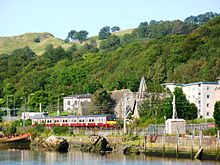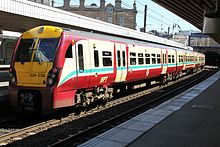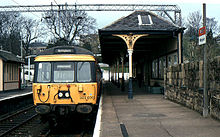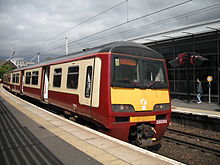- North Clyde Line
-
North Clyde Line
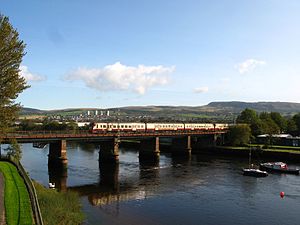
A Class 334 crosses the River Leven between Dumbarton and DalreochOverview Type Heavy rail System National Rail Status Operational Locale Glasgow
Edinburgh
ScotlandTermini West
Helensburgh Central
Balloch
Dalmuir
Milngavie
East
Springburn
Airdrie
Edinburgh WaverleyStations 51 Operation Owner Network Rail Operator(s) First ScotRail Rolling stock Class 320
Class 334 "Juniper"
British Rail Class 318Technical No. of tracks Double track Track gauge 1,435 mm (4 ft 8 1⁄2 in) Electrification 25kV 50hz AC North Clyde Line (Table 226) Legend
Helensburgh Central 
Craigendoran 
Cardross 


Balloch 


Alexandria 


Renton 



Dalreoch 
Dumbarton Central (for West Highland Line) 
Dumbarton East 
Bowling 
Kilpatrick 
Dalmuir (for West Highland Line) 








Clydebank 


Yoker 


Singer 


Drumry 


Drumchapel 


Milngavie 


Hillfoot 


Bearsden 





Westerton 


Anniesland (for Maryhill Line) 


Garscadden 


Scotstounhill 


Jordanhill 



Hyndland 
Partick 


Finnieston West Junction 





Finnieston East Junction 


- - Argyle Line 





Charing Cross 


Glasgow Queen Street ( Buchanan Street)






High Street 


Bellgrove 





Duke Street 


Alexandra Parade 


Barnhill 


Springburn (for Cumbernauld Line) 


Carntyne 


Shettleston 


Garrowhill 


Easterhouse 


Blairhill 


Coatbridge Sunnyside 


Coatdyke 


Airdrie 


Drumgelloch 


Caldercruix 


Blackridge 


Armadale 


Bathgate 


Livingston North 


Uphall 


Edinburgh Park 


Haymarket 


Edinburgh Waverley The North Clyde Line (defined by Network Rail as the Glasgow North Electric Suburban line) is a suburban railway in West Central Scotland. The route is operated by First ScotRail, on behalf of Transport Scotland. As a result of the incorporation of the Airdrie-Bathgate Rail Link and the Edinburgh to Bathgate Line, this route is the fourth rail link between Glasgow and Edinburgh.
Contents
Route
The North Clyde Line, as electrified in 1960, ran east-west through the Greater Glasgow conurbation, linking northern Lanarkshire with western Dunbartonshire, by way of the city centre. Fifty years later, in 2010, the line was extended east from Airdrie, by way of re-opening the line to Bathgate meeting up with the line from Edinburgh.
The main core of the route runs from Edinburgh Waverley to Helensburgh Central via Bathgate and Glasgow Queen Street (Low Level). To the east of the city centre, there is a short branch to Springburn, while to the west there are two routes between Hyndland and Dalmuir (via Singer and via Yoker), as well as branches to Milngavie and Balloch.
The lines from Partick to Dalmuir and Milngavie are also used by Argyle Line services, whilst West Highland Line services share the line between Westerton and Craigendoran. In the east, the line between Newbridge Junction and Edinburgh Waverley is shared with the Glasgow to Edinburgh via Falkirk Line and the Edinburgh to Dunblane Line. In addition to the interchange with services from Glasgow Queen Street (High Level) and Edinburgh Waverley, there are interchanges with the Cumbernauld Line at Springburn, with the Maryhill Line at Anniesland, and with the Glasgow Subway at Partick. Some sections of the North Clyde Line are also traversed by freight trains.
The line runs through central Glasgow, and the principal station on the line is Glasgow Queen Street (Low Level). The section through the city centre largely runs in tunnels between High Street and the former Finnieston station (west of Charing Cross at the intersection of Argyle Street and Kent Road). This is in fact the oldest stretch of underground railway in Glasgow, opened as the Glasgow City & District Railway in 1886 and predating the Glasgow Subway by some ten years.
History
Constituents
Like most of Glasgow's suburban railways, the North Clyde Lines as they are known today were built piecemeal from a patchwork of routes from various Victorian-era railway companies. In addition to the extension east of Airdrie, these are listed below:[1]
- 1842 - Haymarket to Newbridge Junction opened by Edinburgh and Glasgow Railway;
- 1846 - Edinburgh Waverley to Haymarket opened by Edinburgh and Glasgow Railway;
- 1849 - Newbridge Junction to Polkemmet Junction opened by Edinburgh and Bathgate Railway;
- 1850 - Dumbarton Central to Balloch Pier opened by Caledonian and Dunbartonshire Junction Railway;
- 1858 - Cowlairs to Bowling and Dalreoch to Helensburgh Central opened by Glasgow, Dumbarton and Helensburgh Railway;
- 1862 - Polkemmet Junction to Coatbridge Sunnyside opened by Bathgate and Coatbridge Railway;
- 1863 - Westerton to Milngavie opened by Glasgow and Milngavie Junction Railway;
- 1870 - Coatbridge Sunnyside to Bellgrove opened as the Coatbridge Branch of North British Railway;
- 1870 - Bellgrove to High Street Junction opened by City of Glasgow Union Railway;
- 1871 - High Street Junction to College opened as the Coatbridge Branch of North British Railway;
- 1874 - Stobcross to Maryhill opened by Stobcross Railway;
- 1874 - Anniesland to Whiteinch opened by Whiteinch Railway;
- 1875 - Springburn to Bellgrove opened by City of Glasgow Union Railway;
- 1882 - Jordanhill to Clydebank East opened by Glasgow, Yoker and Clydebank Railway;
- 1886 - High Street to Stobcross, Hyndland branch, Jordanhill cord and Anniesland to Westerton cord opened by Glasgow City and District Railway;
- 1891 - Bowling to Dumbarton Central opened by Lanarkshire and Dunbartonshire Railway;
- 1892 - Bridgeton Central to High Street opened by Glasgow City and District Railway;
- 1897 - Clydebank to Dalmuir opened by Glasgow, Yoker and Clydebank Railway;
The majority of these lines were absorbed by (or were subsidiaries of) the North British Railway; the exceptions being the Lanarkshire and Dunbartonshire Railway, which was part of the Caledonian Railway, and the western part of the Caledonian and Dunbartonshire Junction Railway (which was joint between the North British and the Caledonian). At the time of the Grouping in 1923, the North British Railway became part of the London and North Eastern Railway (LNER), while the Caledonian Railway became part of the London, Midland and Scottish Railway (LMS).
Closures
Following nationalisation in 1948, all of the lines came under the ownership of British Railways. A number of former LNER branch lines which fed into the North Clyde system were closed during the 1950s because they duplicated former LMS lines. Other lines closed due to lack of traffic, or later because they were not selected for inclusion in the electrification project. Notable withdrawals of passenger service occurred on:
- 1 May 1930: Manuel and Bathgate to Coatbridge Central (via Blackstone);
- 2 April 1951: Whiteinch Victoria branch, also the Kelvin Valley Line (Maryhill to Kilsyth);
- 10 September 1951: Bothwell to Coatbridge Sunnyside;
- 15 September 1952: Hamilton to Bothwell; [2]
- 4 July 1955: Bothwell to Shettleston;
- 9 January 1956: Ratho to Airdrie;
- 14 September 1959: Clydebank East terminus;
- 5 November 1960: Hyndland branch (replaced by new Hyndland station on main line)
- 5 November 1979: Bridgeton Central branch (replaced by Bridgeton on the Argyle Line)
- 28 September 1986: Balloch Central to Balloch Pier
Re-openings
- 24 March 1986: Newbridge Junction to Bathgate
- May 1989: Airdrie to Drumgelloch
- 18 October 2010: Drumgelloch to Bathgate (line open for driver training and charter trains)
- 12 December 2010: Drumgelloch to Bathgate (passenger services)
Electrification
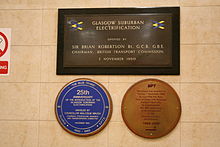 A plaque commemorating the Glasgow suburban electrification by the entrance to the North Clyde Line platforms at Glasgow Queen Street
A plaque commemorating the Glasgow suburban electrification by the entrance to the North Clyde Line platforms at Glasgow Queen Street
In 1960 the remainder of the North Clyde suburban system (Airdrie, Springburn and Bridgeton Central to Milngavie, Balloch Pier and Helensburgh Central, including both routes between Partick and Dalmuir) underwent electrification. A new junction between the former LNER and LMS lines was built at Dunglass, just west of Bowling, allowing North Clyde Line services to use the former LMS (Lanarkshire and Dunbartonshire) line through Dumbarton East, and the original LNER (Caledonian and Dunbartonshire Junction) line from Dunglass to Dumbarton Central was closed. The outer areas were electrified to the 25 kV AC 50 Hz standard, with the central area, the Springburn, Bridgeton and Milngavie branches and the Yoker line being at 6.25 kV AC due to restricted clearances in tunnels. As insulation technology improved these lines were eventually converted to 25 kV.
In October 2010, the line between Bathgate and Airdrie opened complete with electrification at 25 kV for crew training and charter trains. The section between Bathgate and Haymarket (including the section that is common with the Glasgow to Edinburgh via Falkirk Line east of Newbridge Junction) was also electrified at 25 kV. This work was carried out as part of the Airdrie-Bathgate Rail Link.
The Argyle line
The former Caledonian Railway lines in north-west Glasgow and Dunbartonshire (Lanarkshire and Dunbartonshire Railway and Glasgow Central Railway) closed to passengers and then freight. However, the section from Rutherglen through Glasgow Central (Low Level) was reopened as the Argyle Line in 1979. A new flying junction was built east of Partick to connect the Argyle Line with the North Clyde Line. The Bridgeton Central branch closed to passengers on 5 November 1979, having been replaced by the re-opened Bridgeton Cross station on the Argyle Line, though Bridgeton Central station was retained as a carriage cleaning facility. On 17 December 1979, Partickhill station was replaced by the new Partick (Interchange) slightly to the south, which provides a connection with the Subway.
Balloch Pier
Pleasure steamer operations on Loch Lomond ceased in the 1980s, leading to the closure of Balloch Pier terminus station on 28 September 1986. The Balloch line was further truncated in April 1988 when Balloch Central station was replaced by the new Balloch station on the opposite site of Balloch Road, which allowed the elimination of a level crossing. The catenary from the closed section to Balloch Pier was then used to reopen the line east of Airdrie to a new terminus at Drumgelloch in May 1989.[citation needed]
Airdrie-Bathgate Rail Link
Passenger services from Edinburgh to Airdrie ceased in 1956, but the line between Edinburgh and Bathgate was reopened to passenger traffic on a trial basis in 1986 and proved an instant success. In 2005, the Scottish Executive declared that in line with plans to upgrade the remaining section of the A8 road to motorway standard, public transport links between Glasgow and Edinburgh must also be improved. Therefore, to create a fourth direct rail link between Glasgow and Edinburgh, the closed section of the Bathgate and Coatbridge Railway between Bathgate and the 1989 Drumgelloch station was re-opened, and the existing lines from Newbridge Junction to Bathgate and Drumgelloch to Airdrie were upgraded. The whole line is double track and electrified, with a maximum line speed of 80 mph. The existing 30 minute frequency Helensburgh-Drumgelloch and Milngavie-Airdrie services have been extended to Edinburgh Waverley providing an enhanced 15 minute frequency between Bathgate and Edinburgh.
The new link received the final approval of the Scottish Parliament on 28 March 2007 and gained Royal Assent on 9 May 2007. Work commenced with a sod cutting ceremony at Livingston North in June 2007, with reinstatement of double track between Newbridge and Bathgate being the first stage, completed in October 2008. The line is operated by Class 334s and peak Class 320s.
The line opened for driver training and charter trains in October 2010, with the passenger service commencing on 12 December 2010.[3]
Service pattern
Winter 2009/10
- Off-peak Monday to Saturday
- 2tph Helensburgh Central to Drumgelloch
- 2tph Balloch to Airdrie via Singer
- 2tph Dalmuir to Springburn via Yoker
- 2tph Milngavie to Bellgrove
There are also, peak hour limited stop morning commuter services from Balloch to Queen Street and Airdrie to Milngavie. Limited stop evening commuter services run from Queen Street to Balloch.
Argyle Line services provide services from Glasgow Central (Low Level) to Milngavie, Dalmuir (via Yoker) and Dalmuir (via Singer), on 30 minute frequencies.
The section through Patrick and Hyndland stations is one of the busiest in Scotland, with 28 trains per hour using the double track line.
- Monday to Saturday after 6pm
- 2tph Helensburgh Central to Drumgelloch (all stations via Yoker)
- 2tph Balloch to Springburn (all stations via Singer)
Passengers wishing to travel to Milngavie after 7pm must change at Partick or Hyndland for an Argyle Line service.
- Sunday
- 2tph Helensburgh Central to Drumgelloch (all stations via Singer)
Argyle Line services provide services from Glasgow Central (Low Level) to Balloch (via Yoker) and Milngavie on 30 minute frequencies.
Winter 2010/11 (Interim timetable from 12 December 2010)
As a result of delays with commissioning of the Class 380 trains, insufficient Class 334 trains for the full service have been available for introduction of intended timetable from 12 December 2010.[4]
- Off-peak Monday to Friday[5]
- 1tph Helensburgh Central to Edinburgh Waverley
- 1tph Helensburgh Central to Airdrie
- 2tph Balloch to Airdrie via Singer
- 2tph Dalmuir to Springburn via Yoker
- 2tph Milngavie to High Street
- 3tph Bathgate to Edinburgh Waverley
Argyle Line services provide services from Glasgow Central (Low Level) to Milngavie, Dalmuir (via Yoker) and Dalmuir (via Singer), on 30 minute frequencies.
- Monday to Friday after 6pm
- 1tph Helensburgh Central to Edinburgh Waverley (all stations via Yoker)
- 1tph Helensburgh Central to Airdrie (all stations via Yoker)
- 1tph Bathgate to Edinburgh Waverley
- 2tph Balloch to Springburn (all stations via Singer)
Passengers wishing to travel to Milngavie after 7pm must change at Westerton for an Argyle Line service.
- Saturday[6]
- 2tph Helensburgh Central to Edinburgh Waverley
- 2tph Balloch to Airdrie via Singer
- 2tph Dalmuir to Springburn via Yoker
- 2tph Milngavie to Airdrie
- 2tph Bathgate to Edinburgh Waverley
Argyle Line services provide services from Glasgow Central (Low Level) to Milngavie, Dalmuir (via Yoker) and Dalmuir (via Singer), on 30 minute frequencies.
- Saturday after 6pm[6]
- 2tph Helensburgh Central to Edinburgh Waverley (all stations via Yoker)
- 2tph Balloch to Springburn (all stations via Singer)
- Sunday[7]
- 2tph Helensburgh Central to Edinburgh Waverley (all stations via Singer)
- 2tph Dalmuir to Airdrie (all stations via Yoker) - 12 & 19 December 2010 only
- 2tph Dalmuir to Springburn (all station via Singer) - 12 & 19 December 2010 only
Winter 2010/11 (Full service from 12 December 2010)
Following the opening of the line between Airdrie and Bathgate, the service is combined with Edinburgh to Bathgate service, the complete service when sufficient rolling stock is available is:[3]
- Off-peak Monday to Saturday
- 2tph Helensburgh Central to Edinburgh Waverley
- 2tph Balloch to Airdrie via Singer
- 2tph Dalmuir to Springburn via Yoker
- 2tph Milngavie to Edinburgh Waverley
There are also, peak hour limited stop morning commuter services from Balloch to Queen Street and Airdrie to Milngavie. Limited stop evening commuter services run from Queen Street to Balloch. Argyle Line services provide services from Glasgow Central (Low Level) to Milngavie, Dalmuir (via Yoker) and Dalmuir (via Singer), on 30 minute frequencies.
The section through Patrick and Hyndland stations is one of the busiest in Scotland, with 28 trains per hour using the double track line.
- Monday to Saturday after 6pm
- 2tph Helensburgh Central to Edinburgh Waverley (all stations via Yoker)
- 2tph Balloch to Springburn (all stations via Singer)
Passengers wishing to travel to Milngavie after 7pm must change at Westerton for an Argyle Line service.
- Sunday
- 2tph Helensburgh Central to Edinburgh Waverley (all stations via Singer)
- 2tph Dalmuir to Airdrie (all stations via Yoker) - 12 & 19 December 2010 only
- 2tph Dalmuir to Springburn (all station via Singer) - 12 & 19 December 2010 only
Argyle Line services provide services from Glasgow Central (Low Level) to Balloch (via Yoker) and Milngavie on 30 minute frequencies.
Rolling stock
Prior to electrification passenger services were operated primarily by tank engines, notably Class N2 0-6-2T and Class V1/V3 2-6-2T, which were allocated to depots at Parkhead and Kipps (Coatbridge).
Electrification brought the introduction of the legendary and locally-built Class 303 EMUs, operated from a new depot at the former Hyndland terminus station. From 1967 they were joined by the similar Class 311 EMUs, which were built for the Inverclyde Line electrification but which were initially allocated to Hyndland for maintenance and were occasionally used on the North Clyde Line. The Class 303 and 311 trains were nicknamed the "Blue Trains" because of the bright Caledonian Blue colour scheme they carried in the 1960s, at a time when most British Railways passenger stock was painted either green or maroon. In the late 1960s they began to be repainted in the new standard Rail Blue, and from the late 1970s they received coaching stock blue/grey livery. This was followed by the distinctive Strathclyde PTE orange-and-black scheme in the 1980s. A few of the last surviving Class 303s eventually received the new SPT carmine/cream livery in the late 1990s. In September 2008 Transport Scotland announced that the SPT carmine and cream livery would be discontinued; trains will start to be repainted in a new, blue livery with white Saltire motifs at the ends of each carriage.
In the 1970s, a new electric locomotive/EMU depot was built at Shields Road south of the Clyde, and this took over maintenance of the EMUs used on the Cathcart Circle and Inverclyde Lines, including all of the Class 311s. However, reopening of the Argyle Line in 1979 resulted in the introduction of Class 314 EMUs, which were allocated to Hyndland but used almost exclusively on the Argyle Line but it was still used on the North Clyde line. In 1987, Hyndland depot closed and was replaced by new carriage sidings at Yoker, with maintenance transferred to Shields Road. Thereafter, Class 311s began to appear more frequently on some North Clyde services. However, it was not until 1990 that a start was made on replacing the Class 303s, which still operated the great majority of services on the North Clyde Line.
Class 320 EMUs were introduced in 1990 and took over most North Clyde services, enabled the withdrawal of many Class 303s and all of the 311s. A few Class 303 units continued to operate on the North Clyde Line until December 2002, when they were finally withdrawn. They were replaced by the Class 334 Alstom "Juniper" EMUs, together with Class 318 units which had been cascaded from the Ayrshire Coast Lines. The Class 318s and 334s also replaced the Class 314 units on the Argyle Line, and these were in turn been displaced to the Cathcart Circle and Inverclyde Lines (to replace the last 303s).
From May 2011 Class 334 and Class 320 operate all North Clyde line services. Class 318 are also seen on tracks shared with Argyle Line services.
Future development
Crossrail Glasgow
With many passengers travelling north-south through the city centre having to walk or use a shuttle bus between Central and Queen Street stations, SPT has long proposed a direct rail link between the North Clyde system and the lines radiating from Glasgow Central (High Level). This would allow direct service from Renfrewshire and Ayrshire stations to Glasgow Queen Street (Low Level), and would also allow new cross-city services such as Airdrie to Paisley. The plan would involve re-opening to passenger traffic the freight-only City Union Line between Shields Junction and Bellgrove, and building a new curve between Gallowgate and High Street. Reopening of the closed line from Strathbungo to Gorbals would allow trains from Barrhead and East Kilbride to use Crossrail. Funding for the scheme has yet to be sought, and the project remains a long term aspiration only.
Accidents and incidents
- On 11 September 1986 two railwaymen were killed in a collision between two trains at Bridgeton Central carriage sidings;
- On 6 March 1989 two people were killed when two trains collided head-on at Bellgrove.
References
Notes
- ^ Awdry (1990)
- ^ http://www.postmaster.co.uk/~notberkscc/198388/page_1.html
- ^ a b "National Rail Timetable 226; December 2010". http://www.networkrail.co.uk/browse%20documents/eNRT/Dec10/timetables/Table226.pdf. Retrieved 17 November 2010.
- ^ "We've added something new to Central Scotland". http://www.scotrail.co.uk/a-b.
- ^ "Interim timetable: Edinburgh to/from Helensburgh MONDAY TO FRIDAY Service". http://www.scotrail.co.uk/sites/default/files/documents/A2B_TT_Mon-Fri.pdf. Retrieved 3 January 2011.
- ^ a b "Interim timetable: Edinburgh to/from Helensburgh SATURDAY Service". http://www.scotrail.co.uk/sites/default/files/documents/A2B_TT_Sat.pdf. Retrieved 3 January 2011.
- ^ "Interim timetable: Edinburgh to/from Helensburgh SUNDAY Service". http://www.scotrail.co.uk/sites/default/files/documents/A2B_TT_Sun.pdf. Retrieved 3 January 2011.
Sources
- Awdry, Christopher (1990). Encyclopaedia of British Railway Companies. Sparkford: Patrick Stephens Ltd. ISBN 1-8526-0049-7. OCLC 19514063.
- Jowett, Alan (March 1989). Jowett's Railway Atlas of Great Britain and Ireland: From Pre-Grouping to the Present Day (1st ed.). Sparkford: Patrick Stephens Ltd. ISBN 1-8526-0086-1. OCLC 22311137.
Railway lines in Scotland InterCity lines Overnight Services Main lines Ayrshire Coast · Glasgow-Edinburgh (via Carstairs) · Glasgow-Edinburgh (via Falkirk) · Edinburgh-Aberdeen · Glasgow-Aberdeen · Glasgow South Western · HighlandGlasgow commuter lines █ Argyle · █ Ayrshire Coast · █ Cathcart Circle · █ Croy (and Alloa) · █ Cumbernauld (and Falkirk) · █ Inverclyde · █ Maryhill · █ Motherwell-Cumbernauld · █ North Clyde · █ Paisley Canal · █ Shotts · █ South Western · █ WhiffletEdinburgh commuter lines Rural lines Future lines Completed projects Categories:- Transport in Glasgow
- Railway lines in Scotland
- Standard gauge railways in Scotland
Wikimedia Foundation. 2010.

